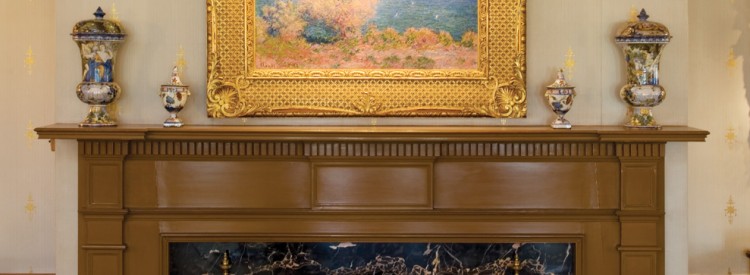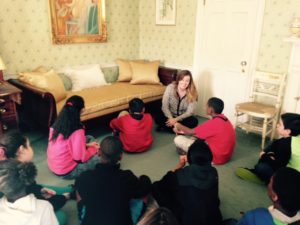OVERVIEW
 Meet Monet and friends at Hill-Stead!
Meet Monet and friends at Hill-Stead!
Tour the historic house, built in 1901, and contemplate artworks by Impressionist masters in the intimacy of the Pope family home. View and analyze the works of Impressionist painters, including Claude Monet, Edgar Degas, Mary Cassatt, as well as the influential eighteenth- and ninetheenth– century Japanese woodblock prints which inspired their art. Learn about the friendships from primary resources, between the Pope family and Monet and Cassatt.
Learning Objectives
Students will learn about the Impressionist artists, known for their sketch-like brushwork and juxtaposition of bright colors to represent the effect of light on objects. Students will also learn how this style was in contrast to academic art favored by the jurors of the Paris salon. The Hill-Stead school group tour is highlighted with visual literacy exercises where students will describe, analyze, interpret, and judge selected works of art.
- Impressionists: Students will view original paintings and pastels by noted masters, and come to appreciate the similarities and differences between their individual paintings. Students will become familiar with the sketch-like brushwork, simplified forms, and en plein air technique of this group of pioneering artists. Contemplating the canvases takes on additional meaning as students learn about the special relationship that the Popes shared with many of the artists in this community of Impressionists. Impressionist art will be compared to Japanese woodblock prints, a genre inspirational to these noted artists. Students will observe and discuss the elements of art rendered in the paintings and the prints.
- Subject Matter: The subject matter of the Impressionists was of contemporary and everyday life. The artists continued many traditions, but also broke away in new directions, focusing on outdoor light.
- Elements of Art: Students will learn about these building blocks of art and examine how the Impressionists applied them when creating their works of art. Students will also consider and examine the various palettes and techniques used by the Impressionists. Museum Educators will facilitate a discussion using visual thinking strategies to compare works of art and analyze the merits of a particular artist’s choices.
Collection Connections
To view these paintings, follow the links below.
Claude Monet
- Fishing Boats at Sea, ca. 1867-69
- View of Cap D’Antibes, 1888
- Grainstacks, White Frost Effect, 1889
- Grainstacks, In Bright Sunlight, 1890
Edgar Degas
Édouard Manet
Mary Cassatt
- Sarah Handing a Toy to the Baby, c. 1901
- Gathering Fruit, 1893 (need image)
Other works
- Japanese Woodblock Prints: including Hiroshige, Hokusai, and Utamar
- Archival documents (receipts, letters)
- Theodate Pope Riddle diary excerpts
For more information on individual artists and paintings, follow these links to the Our Collection section of our website.
Vocabulary
For a printable vocabulary list, see Vocabulary for At Home with the Impressionists.
- Academic art: Art that conforms to the standards of the French Academy, the official body that promoted traditional art based on classical ideals.
- Elements of Art: The building blocks of art creation which are manipulated and organized by artists. They include line, color, texture, and shape.
- En Plein air: French, meaning open air, painting out of doors.
- Impressionist art: A style of art, which developed around 1870, generally devoted to subjects of leisure, the upper-middle class, and the city rendered in a naturalist manner often painted directly before nature, en plein air. A style known for its sketch-like brushwork and simplified forms, leaving the viewer with an “impression” of a scene rather than an immensity of detail, and a lack of traditional finish. Typically, this work is characterized by short brush strokes of bright colors in immediate juxtaposition to represent the effect of light on objects.
- Japanese woodblock prints: A print rendered from a wood block that is carved to depict an image. The best known type is the ukiyo-e (floating world), a genre produced between the 17th and 20th centuries, featuring motifs of landscapes, tales from history, the theater, and the pleasure quarters.
- Painting: A picture or design executed in paints.
- Palette: Both the flat surface on which the artist sets out and mixes paints, and the range of pigments used in a painting.
- Pastel: A drawing medium of dried paste made of ground pigments and a water-based binder that is manufactured in crayon form; a picture or sketch drawn with this type of crayon.
- Patron: One that supports, protects, or champions someone or something, such as an institution, event, or cause; a sponsor or benefactor: a patron of the arts.
- Portrait: A likeness of a person, especially of the face in a painting, drawing or photograph
- Realism: is a style of painting that depicts the actuality of what the eyes can see.
- Salon: The official annual art exhibition in Paris first established in the 17th century by the French Art Academy.
- Seascape: A painting which depicts the sea or ocean

